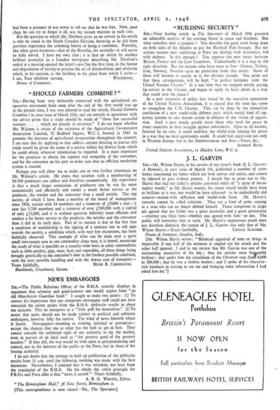" SHOULD FARMERS COMBINE ? "
Sut,—Having been very intimately connected with the agricultural co- operative movement from soon after the end of the first world war up to the present time, I was very pleased to read the article, Should Farmers Combine ? in your issue of March 12th, and am entirely in agreement with the advice given that a study should be made of " those few successful ventures . . . which are already in existence." I do not know whether Mr. Walston is aware of the existence of the Agricultural Co-operative Association Limited, 32 Bedford Square, W.C. 1, formed in 1945 to promote the interests of agricultural co-operation throughout the country. I am sure that by applying to that address anyone desiring to pursue this study would be given the name of a society within his districtfrom which he could obtain whatever information he required. It is most important for the producer to obtain the support and sympathy of the consumer, and for the consumer on his part to make sure that an efficient marketing system is created.
Perhaps you will allow me to make one or two further comments on Mr. Walston's article. He states that societies with a membership of 50-500 producers can collect and distribute economically. My experience is that a much larger association of producers can be run far more economically and efficiently and render a much better service to the producer, the retailer and the consumer than a small society. The egg society, of which I have been a member of the board of management since 1926, started with 14 members and a turnover of £9,000 a year ; it now has 3,700 members and a turnover of over £500,000 with a capital of only £12,000, and it is without question infinitely more efficient and renders a far better service to the producer, the retailer and the consumer than it did in its early days. Part of its success is due to the fact that a condition of membership is the signing of a contract not to sell eggs outside the society, a condition which, with very few exceptions, has been faithfully observed. This example of what can be done over a quite small two-county area in one commodity alone may, it is hoped, encourage the study of what is possible on a country-wide basis in other commodities such as table-poultry, pigs, meat, fruit and vegetables, all these things being brought practically to the consumer's door in the freshest possible condition, with the least possible handling and with the lowest cost of transport.—






























 Previous page
Previous page